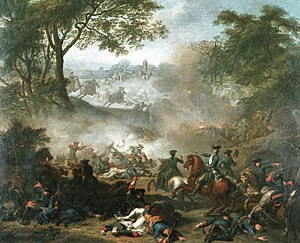Battle of Lesnaya
| Battle of Lesnaya | |||||||
|---|---|---|---|---|---|---|---|
| Part of the Great Northern War | |||||||
 Battle of Lesnaya by Jean-Marc Nattier, painted 1717 | |||||||
| |||||||
| Belligerents | |||||||
|
|
| ||||||
| Commanders and leaders | |||||||
| General Adam Ludwig Lewenhaupt | Tsar Peter the Great | ||||||
| Strength | |||||||
| 12,500 | 5000 infantry, 7000 cavalry. 5000 cavalry arrived at the end of the battle | ||||||
| Casualties and losses | |||||||
|
6,307 of whom about 1,000 were killed[2] 700 and supply wagons captured | 1,111 killed; 2,856 wounded | ||||||
The Battle of Lesnaya was one of the decisive battles of the Great Northern War. It took place on September 28, 1708 between a Russian army of 12,000 (14,500 by Swedish sources) men commanded by Princes Repnin and Menshikov and a Swedish force of 16,000 (12,500 by Swedish sources) men, under the command of General Adam Ludwig Lewenhaupt, at the village of Lesnaya, located on the border between Poland and Russia (now the village of Lisna, Belarus).
Background
Early Swedish victories at Copenhagen and at the Battle of Narva in 1702 knocked both Denmark and Russia temporarily out of the war. However, Charles was unable to bring the war to a conclusion, and it would be eight years before he dealt with the remaining combatant Charles Augustus of Saxony-Poland. During this time Peter rebuilt his army into modern form, basing it primarily on infantry trained to properly use linear tactics and modern firearms. He then achieved a stunning propaganda victory in Livonia, where he established the city of Saint Petersburg. Incensed, Charles ordered a fatal attack on the Russian heartland with an assault on Moscow from his campaign base in Poland.
Lewenhaupt, one of Sweden's foremost generals, was the commander of one of Sweden's best armies, based at the Baltic Sea port of Riga. In the summer of 1708, King Charles XII of Sweden ordered him to march southward with most of his force and link up with Charles main army of 25,000 men, based in Poland. Lewenhaupt was to bring a fresh supply of ammunition and food to support the Swedish army in a proposed march on the Russian capital of Moscow.
However, Lewenhaupt found that gathering the needed supplies and preparing the army for an overland march took longer than expected, and on September 15, after waiting for Lewenhaupt for weeks, Charles XII abandoned his camps and decided to invade the Ukraine, hoping to reach that rich granary before winter. At the time, Lewenhaupt was only about 80 miles from Charles' position.
The Russians observed these movements and Peter decided the time was ripe to attack Lewenhaupt's smaller force before it could be supported by Charles. He and Menshikov moved quickly to intercept the Swedish force and prevented it from crossing the Sozh River to safety. Lewenhaupt was not fazed; no Swedish army had yet been defeated by the Russians in eight years of war. He moved to fight Peter's army.
Battle
The battle itself was closely contested and both forces suffered heavy casualties. Late in the day, a snowstorm, something rare for September even in Russia, kicked up. The Swedes, unaccustomed to fighting in the snow, became disorganized and Lewenhaupt ordered his men to retreat, while burning the much-needed supply wagons behind them. Menshikov now ordered his cavalry to attack one more time, and routed the Swedes. Kalmyks and Cossacks then completed the Russian victory by taking hundreds of prisoners.
Results
The Swedes lost 6,307 men in the battle, more than half of them prisoners. Russian casualties totaled 1,111 killed and 2,856 wounded, about one-third of those engaged.
Lewenhaupt decided to rejoin Charles with all speed, so he abandoned the cannon, the cattle and most of the food, driving the soldiers to mutiny. Stealing all of the alcohol, the soldiers became drunk, and Lewenhaupt was forced to leave about 1,000 men drunk in the woods. By the time they finally reached Charles and the main force on October 8, no supplies and only 6,000 men remained, only increasing his problem of feeding the army.
The greatest significance of the Russian victory at Lesnaya was that it convinced the Russian soldiers that they could defeat even Sweden's best soldiers. This newfound confidence served them well in the 1709 campaign in which Peter destroyed Charles' main Swedish army. Peter referred to Lesnaya as "the mother of the Battle of Poltava."
Note
Sweden had its own calendar between 1700 and 1712, so in the Swedish calendar the battle of Lesnaya took place on September 29, 1708.
References
Literature
- History of the Art of War - История военного искусства / Под общ. ред П.Д. Ротмистрова. — М., 1963. - T.I. - С. 132-135.
- History of the Northern War - История Северной войны. 1700—1721. / Отв. ред. И.И. Ростунов. — М., 1987. С. 73-76.
- The Book of Marsov or of Affairs of War - Книга Марсова или воинских дел. — Изд.2. — СПб., 1766.
- Kresnovsky's History of the Russian Army, from Narva to Paris: 1700-1814 - Кресновский А.А. История русской армии: В 4-х т. — М., 1992. — T.I. От Нарвы до Парижа 1700—1814. — С. 35—36.
- Letters and papers by Emperor Peter the Great - Письма и бумаги императора Петра Великого. — Т.5. — СПб., 1907.
- Soviet War Encyclopaedia - Советская военная энциклопедия: В 8-й т. / Гл. ред. комис. Н.В. Огарков (пред.) и др. — М., 1977. — Т.4. — С. 624.
- Strokov's History of the Art of War - Строков А.А. История военного искусства. —М., 1955. —T.I. — С. 496.
